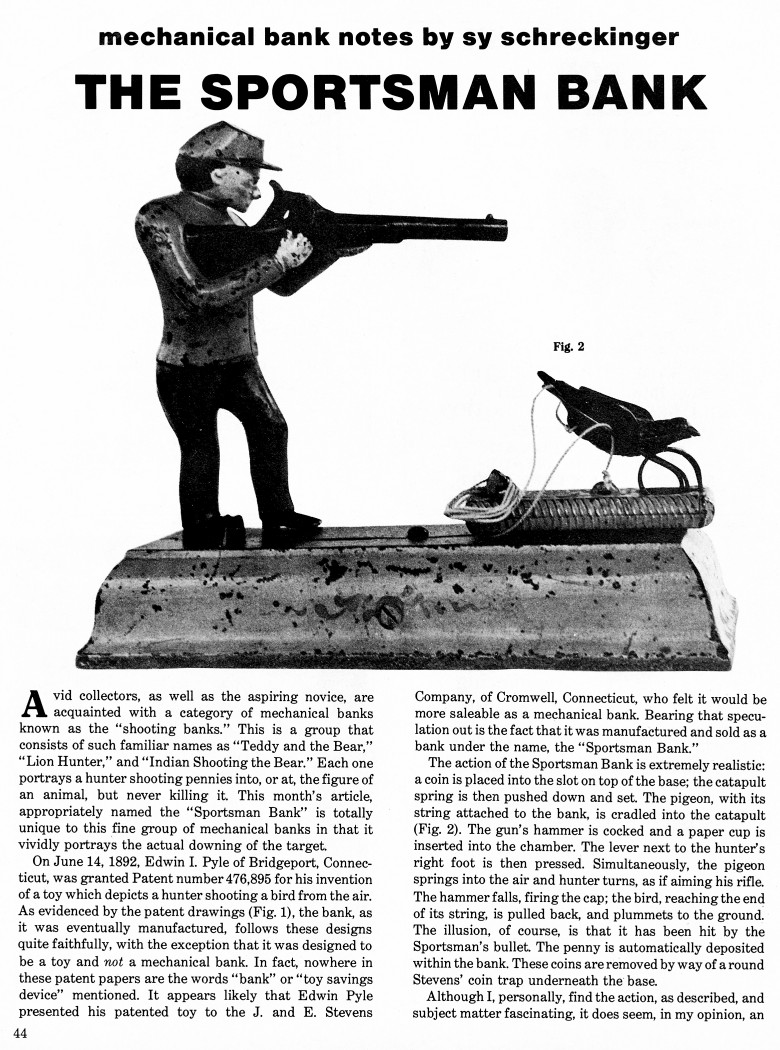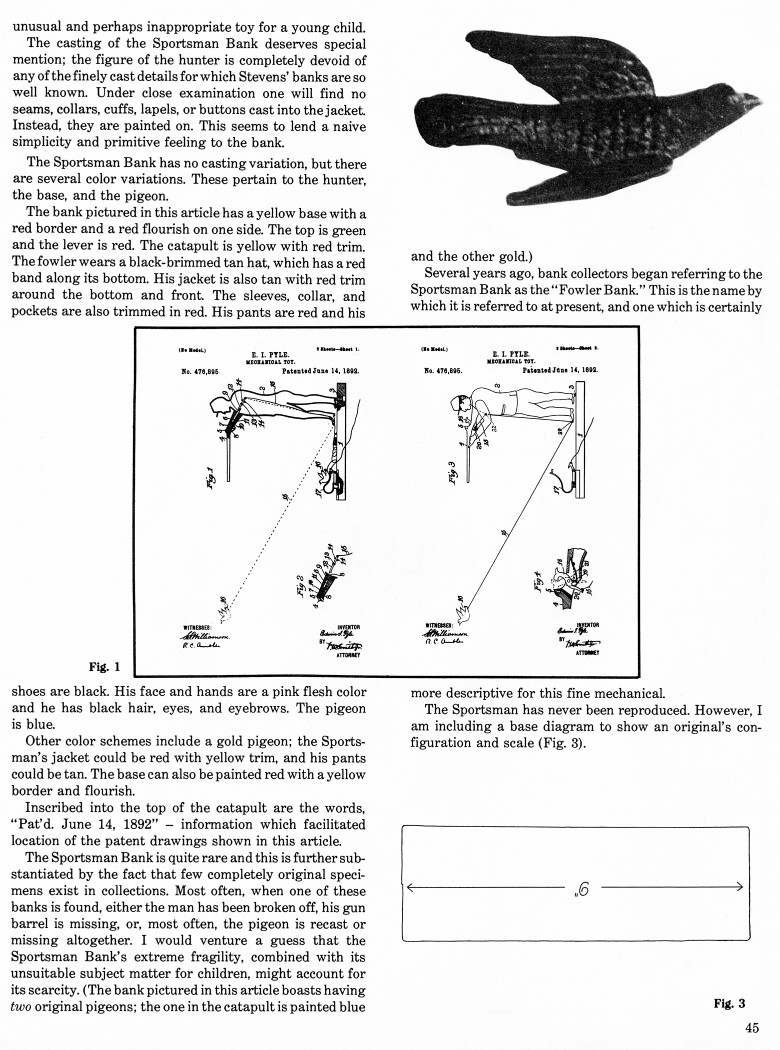|
The Sportsman Bank
by Sy Schreckinger – ANTIQUE TOY WORLD Magazine – June, 1984
Avid collectors, as well as the
aspiring novice, are acquainted with a category of mechanical banks known
as the "shooting banks." This is a group that consists of such familiar
names as "Teddy and the Bear," "Lion Hunter," and "Indian Shooting the
Bear." Each one portrays a hunter shooting pennies into, or at, the figure
of an animal, but never killing it. This month's article, appropriately
named the "Sportsman Bank" is totally unique to this fine group of
mechanical banks in that it vividly portrays the actual downing of the
target.
On June 14, 1892, Edwin I. Pyle of Bridgeport, Connecticut, was
granted Patent number
476,895 for his invention of a toy which depicts a
hunter shooting a bird from the air. As evidenced by the patent drawings
(Fig. 1), the bank, as it was eventually manufactured, follows these
designs quite faithfully, with the exception that it was designed to be a
toy and not a mechanical bank. In fact, nowhere in these patent papers are
the words "bank" or "toy savings device" mentioned. It appears likely that
Edwin Pyle presented his patented toy to the J. and E. Stevens Company, of
Cromwell, Connecticut, who felt it would be more saleable as a mechanical
bank. Bearing that speculation out is the fact that it was manufactured
and sold as a bank under the name, the "Sportsman Bank."
The action of the Sportsman Bank is extremely realistic: a coin is
placed into the slot on top of the base; the catapult spring is then
pushed down and set. The pigeon, with its string attached to the bank, is
cradled into the catapult (Fig. 2). The gun's hammer is cocked and a paper
cup is inserted into the chamber. The lever next to the hunter's right
foot is then pressed. Simultaneously, the pigeon springs into the air and
hunter turns, as if aiming his rifle. The hammer falls, firing the cap;
the bird, reaching the end of its string, is pulled back, and plummets to
the ground. The illusion, of course, is that it has been hit by the
Sportsman's bullet. The penny is automatically deposited within the bank.
These coins are removed by way of a round Stevens' coin trap underneath
the base.
Although I, personally, find the action, as described, and subject
matter fascinating, it does seem, in my opinion, an unusual and perhaps
inappropriate toy for a young child.
The casting of the Sportsman Bank deserves special mention; the
figure of the hunter is completely devoid of any of the finely cast
details for which Stevens' banks are so well known. Under close
examination one will find no seams, collars, cuffs, lapels, or buttons
cast into the jacket. Instead, they are painted on. This seems to lend a
naive simplicity and primitive feeling to the bank.
The Sportsman Bank has no casting variation, but there are several
color variations. These pertain to the hunter, the base, and the pigeon.
The bank pictured in this article has a yellow base with a red border
and a red flourish on one side. The top is green and the lever is red. The
catapult is yellow with red trim. The fowler wears a black-brimmed tan
hat, which has a red band along its bottom. His jacket is also tan with
red trim around the bottom and front. The sleeves, collar, and pockets are
also trimmed in red. His pants are red and his shoes are black. His face
and hands are a pink flesh color and he has black hair, eyes, and
eyebrows. The pigeon is blue.
Other color schemes include a gold pigeon; the Sportsman's jacket
could be red with yellow trim, and his pants could be tan. The base can
also be painted red with a yellow border and flourish.
Inscribed into the top of the catapult are the words, "Pat'd. June
14, 1892" – information which facilitated location of the patent drawings
shown in this article.
The Sportsman Bank is quite rare and this is further substantiated by
the fact that few completely original specimens exist in collections. Most
often, when one of these banks is found, either the man has been broken
off, his gun barrel is missing, or, most often, the pigeon is recast or
missing altogether. I would venture a guess that the Sportsman Bank's
extreme fragility, combined with its unsuitable subject matter for
children, might account for its scarcity. (The bank pictured in this
article boasts having two original pigeons; the one in the catapult is
painted blue and the other gold.)
Several years ago, bank collectors began referring to the Sportsman
Bank as the "Fowler Bank." This is the name by which it is referred to at
present, and one which is certainly more descriptive for this fine
mechanical.
The Sportsman has never been reproduced. However, I am including a
base diagram to show an original's configuration and scale (Fig. 3).
Correction: (from
August, 1984) Re:
June 1984 issue of Antique Toy World, "The Sportsman
Mechanical Bank." Figure 3, illustrating the base diagram, was placed
upside down. It should read "9 inches" and not 6 inches.
|


